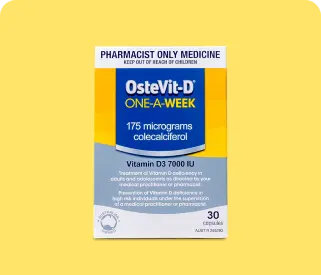Frequently asked questions
Despite Australia’s climate, low vitamin D levels are common amongst Australians. Even in the sunshine state of Queensland, one study found that 4 in 10 women had low vitamin D levels at the end of winter. If you live in the lower (or southern parts of Australia, latitude > 35o S) the risk of vitamin D deficiency increases.
Ebeling PR, et al. Building healthy bones throughout life: an evidence-informed strategy to prevent osteoporosis in Australia. Med J Aust. 2013;199:S1-S46
There are a number of different factors that can increase your risk of having low vitamin D levels such as:
- People who are less likely to spend time in the sun, such as office workers and shift workers
- People with darker skin
- People who wear modest clothes, covering most of their skin
- People living in aged care facilities
- Infants if the mother was vitamin D deficient during pregnancy
People at risk of low calcium levels include those who do not eat calcium-rich diets. This most commonly occurs in people who avoid or don’t eat a typical amount of dairy products such as milk, yogurt and cheeses. Typically adults need to eat 3 to 4 serves of calcium-containing foods each day to get adequate calcium levels.
Over half of all Australians aged 2 years or older have diets that do not provide the recommended calcium intake. It is important to understand that our calcium needs change over time. Our need for calcium is higher during teenage years when we are growing bone mass. Another peak period for women is around menopause.
Australian Bureau of Statistics, Australian Health Survey: Usual Nutrient Intakes, 2011-12, 4364.0.55.008.
To keep your bones as healthy as possible:
- Eat foods rich in calcium, such as milk, yogurt and green leafy vegetables
- Have safe exposure to the sunlight
- Be physically active for at least 30 minutes on most days of the week, e.g. go for a daily walk
- Avoid smoking
- Limit the amount of alcohol you drink to 1 or 2 standard drinks per day
- Take a calcium and/or vitamin D supplement if you do not get enough through your diet and lifestyle.
In general you should consider taking vitamin D supplement if you have low vitamin D levels or are at high risk of this. The need for additional calcium is usually worked out by understanding if your diet is low in calcium-rich foods (mainly dairy-based foods). If you eat 3-4 serves of calcium-rich foods per day you may not need to take additional calcium. Your pharmacist or doctor will be able to help you with additional advice regarding your specific situation.
Getting too much calcium can cause constipation.
The upper recommended limit of calcium per diet from all sources (your diet and supplements) in Australia is 2500 mg/day. This is much higher than found in individual supplements that typically contain 600 mg/dose. Please be aware that some antacids also contain calcium, so if you regularly use antacids you should check with your pharmacist or doctor on what is best for you.
Vitamin D deficiency often has no symptoms but may cause muscle weakness and joint pain if the level is very low.
Vitamin D does not interact with any other medications but some prescription medications may cause vitamin D deficiency as they increase the degradation of vitamin D.
Most multi-vitamins contain around 400 IU of vitamin D and the daily requirement for adults is 1000 IU of vitamin D.
Vitamin D3 is the form that your body manufactures from the sun and the form found in oily fish. Vitamin D2 is the form found in some plants. OsteVit-D contains vitamin D3.
OsteVit-D is available in a liquid formulation for adults and as a children’s formulation with a pleasant butterscotch flavour. We also offer OsteVit Vitamin D Melts.
A baby’s vitamin D levels reflect that of the mother. If a mother has low levels of vitamin D her baby will also be deficient and so will her breast milk. OsteVit-D Vitamin D3 Kids Drops are suitable for infants and children aged 0-12 years and are sugar free.
OsteVit-D One-A-Day Vitamin D3 & Calcium tablets are chewable and they have a pleasant French vanilla flavour.
The type of calcium in OsteVit-D One-A-Day Vitamin D3 & Calcium is calcium carbonate. Products containing calcium carbonate should be taken with food to ensure that they are properly absorbed.
Calcium supplements are usually well tolerated. Occasionally they may cause constipation, bloating and flatulence.
Always read the label and follow the directions for use.
ASK YOUR PHARMACIST ABOUT THIS PRODUCT.
About Bone Health

Vitamin D and Mental Health: Exploring the Connection 7
Investigate the potential links between Vitamin D levels and mental health. Discuss studies that… Lorem ipsum dolor sit amet, consectetur adipiscing elit.Lorem ipsum dolor sit

Vitamin D and Mental Health: Exploring the Connection 4
Investigate the potential links between Vitamin D levels and mental health. Discuss studies that… Lorem ipsum dolor sit amet, consectetur adipiscing elit.Lorem ipsum dolor sit

Vitamin D and Mental Health: Exploring the Connection 6
Investigate the potential links between Vitamin D levels and mental health. Discuss studies that… Lorem ipsum dolor sit amet, consectetur adipiscing elit.Lorem ipsum dolor sit

The Importance of Vitamin D in Bone Health: A Comprehensive Guide 5
Lorem ipsum dolor sit amet, consectetur adipiscing elit.Lorem ipsum dolor sit amet consectetur. Varius id libero felis convallis id lacus. Nec eget in sagittis odio.
